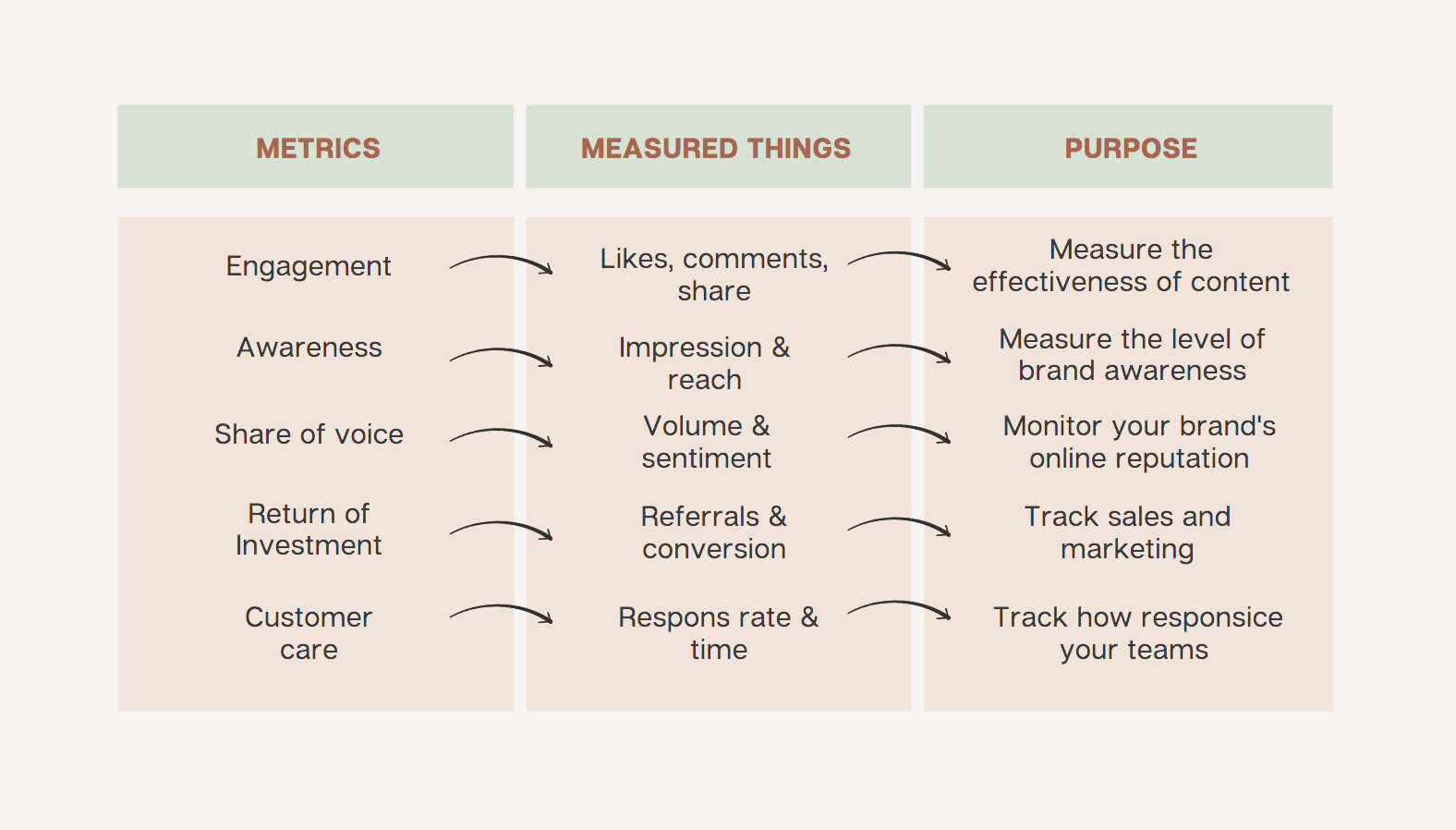Influencer marketing has become super popular in recent years as businesses have started working with social media influencers to promote their products and services. Basically, influencer marketing involves partnering with people who have a big following online and using them to promote your brand to their followers through sponsored content or endorsements.
While influencer marketing can be a great way to reach new customers and boost brand awareness, it's important to know how well your influencer marketing campaigns are performing. That's where influencer marketing metrics come in.
These are specific metrics that help businesses measure the success of their influencer marketing campaigns and figure out if their investment in influencer marketing is worth it.
In this article, we'll go over some common influencer marketing metrics, the importance of setting goals and objectives for an influencer marketing campaign, and the best ways to track and analyze influencer marketing metrics to evaluate the effectiveness of a campaign.
When brands understand how influencer campaigns fit into their operating expenses, it becomes much easier to compare ROI across marketing channels.
Metrics
Influencer marketing metrics are specific metrics used to measure the performance of an influencer marketing campaign and help businesses determine the success of their investment in influencer marketing.
- Reach: This metric refers to the number of people who have seen an influencer's sponsored content or ad. Reach can be a useful metric for assessing the overall visibility of a campaign, but it's important to note that simply having a large reach doesn't necessarily mean that the campaign is effective.
- Engagement: Engagement refers to the level of interaction that an influencer's content receives, such as likes, comments, and shares. Higher engagement can indicate that an influencer's content is resonating with their audience and that the campaign is successful at generating interest and involvement.
- Conversion rate: The conversion rate refers to the percentage of people who take a specific action (such as purchasing a product or signing up for a newsletter) after seeing an influencer's sponsored content or ad. A high conversion rate can indicate that an influencer's content is effective at driving desired actions from their audience.
- Sales or revenue generated: For businesses that are primarily interested in driving sales through influencer marketing, tracking the sales or revenue generated by a campaign can be a useful metric. This can help businesses determine the return on investment (ROI) of their influencer marketing efforts. For larger brands, evaluating ROI alongside EBITDA can paint a clearer picture of how influencer marketing contributes to long-term profitability.

The importance of setting goals
Setting clear goals and objectives for an influencer marketing campaign is important because it helps ensure that the right metrics are being used to evaluate the success of the campaign. Without clear goals, it can be difficult to determine whether an influencer marketing campaign is meeting its objectives and delivering the desired results.
Some examples of goals that businesses might set for an influencer marketing campaign include:
- Increasing brand awareness
- Generating sales or revenue
- Driving traffic to a website
- Increasing engagement on social media
- Building an email list
Each of these goals will require different metrics to measure success, so it's important to carefully consider the specific objectives of a campaign before selecting metrics to track. For example, if the goal of a campaign is to increase brand awareness, metrics such as reach and engagement might be most relevant, while if the goal is to generate sales, metrics such as conversion rate and revenue generated might be more important.
By setting clear goals and objectives for an influencer marketing campaign, businesses can ensure that they are focusing on the right metrics and making informed decisions about the success of the campaign.
Looking to jump into the world of influencer marketing? Connect with Social Cat for a complimentary trial or book a demo and learn how to work with micro-influencers to boost your brand.
Common metrics in influencer marketing
- Cost per acquisition (CPA): CPA is a metric that measures the cost of acquiring a new customer through an influencer marketing campaign. It is calculated by dividing the total cost of the campaign by the number of new customers acquired. For example, if an influencer marketing campaign costs $500 and results in 10 new customers, the CPA would be $50 ($500 / 10). These formulas work similarly to cost accounting, where every expense is analyzed to understand the exact cost of generating results.
- Cost per lead (CPL): CPL is a metric that measures the cost of generating a lead (such as a person signing up for a newsletter or filling out a contact form) through an influencer marketing campaign. It is calculated by dividing the total cost of the campaign by the number of leads generated. For example, if an influencer marketing campaign costs $500 and generates 50 leads, the CPL would be $10 ($500 / 50).
- Click-through rate (CTR): CTR is a metric that measures the percentage of people who click on an influencer's sponsored content or ad. It is calculated by dividing the number of clicks by the number of impressions (the number of times the content or ad was shown) and multiplying by 100. For example, if an influencer's sponsored content is shown 1000 times and receives 100 clicks, the CTR would be 10% (100 / 1000 * 100).
- Cost per engagement (CPE): CPE is a metric that measures the cost of generating an engagement (such as a like, comment, or share) through an influencer marketing campaign. It is calculated by dividing the total cost of the campaign by the number of engagements generated. For example, if an influencer marketing campaign costs $500 and generates 1000 engagements, the CPE would be $0.50 ($500 / 1000).
- Return on investment (ROI): ROI is a metric that measures the profitability of an influencer marketing campaign. It is calculated by dividing the net profit generated by the campaign by the total cost of the campaign and multiplying by 100. For example, if an influencer marketing campaign generates $1000 in net profit and costs $500, the ROI would be 100% ($1000 / $500 * 100).
These are just a few examples of influencer marketing metrics, and the specific metrics that are most relevant for a campaign will depend on the goals and objectives of the campaign. Many of these metrics mirror principles from managerial accounting, where tracking costs and performance helps marketers understand the true efficiency of a campaign.
The limitations of using individual metrics in isolation
Using individual influencer marketing metrics in isolation can be limiting because it can give an incomplete picture of the performance of a campaign. For example, if a campaign has a high reach but low engagement, it could indicate that the content is being seen by a lot of people but is not resonating with the audience. Similarly, a campaign with a high conversion rate but low reach might be generating a lot of sales, but it might be missing out on the opportunity to reach a larger audience.
To get a more holistic view of the performance of an influencer marketing campaign, it's important to consider a range of metrics, rather than just focusing on a single metric. This can help give a more complete picture of the campaign's strengths and weaknesses, and can help identify opportunities for improvement.
For example, if a campaign has a high reach but low engagement, it might be worth analyzing the content being shared to identify why it is not resonating with the audience. On the other hand, if a campaign has a high conversion rate but low reach, it might be worth considering ways to expand the reach of the content to capture a larger audience.
Benchmarks and industry standards can be useful for interpreting influencer marketing metrics and evaluating the performance of a campaign in the context of the wider industry.
For example, if the average engagement rate for an influencer marketing campaign in a particular industry is 5%, a campaign with an engagement rate of 10% could be considered to be performing well, while a campaign with an engagement rate of 2% might be underperforming.
However, it's important to note that benchmarks and industry standards can vary widely depending on the specific industry and the goals of a campaign, and it's important to consider the specific context in which an influencer is operating when evaluating their performance.
For example, an influencer with a large and engaged following in a niche market might be able to achieve higher engagement rates than an influencer with a more general audience, even if their reach is smaller. In this case, it might be more relevant to compare the influencer's performance to other influencers in their specific niche, rather than to industry-wide benchmarks.
Overall, considering benchmarks and industry standards can be a helpful way to interpret influencer marketing metrics and evaluate the performance of a campaign, but it's important to keep in mind the specific context in which the campaign is being run.
Looking to jump into the world of influencer marketing? Connect with Social Cat for a complimentary trial or book a demo and learn how to work with micro-influencers to boost your brand.
Strategies for tracking and analyzing influencer marketing metrics over time
- Set up tracking and reporting systems: To effectively track and analyze influencer marketing metrics over time, businesses need to have systems in place for collecting and organizing data. This might involve using tools such as Google Analytics or social media analytics platforms to track key metrics, or setting up custom tracking systems to capture specific data points.
- Regularly review and analyze data: To get the most value from influencer marketing metrics, businesses need to be proactive about reviewing and analyzing data on a regular basis. This might involve setting up regular reporting schedules, such as monthly or quarterly reviews, to ensure that data is being reviewed on a regular basis.
- Identify trends and patterns: By tracking and analyzing influencer marketing metrics over time, businesses can identify trends and patterns in performance. For example, they might notice that certain types of content tend to generate higher engagement rates, or that certain influencers are more effective at driving conversions. Identifying these trends and patterns can help businesses make more informed decisions about the direction of their influencer marketing efforts.
- Use data to optimize campaigns: By regularly reviewing and analyzing influencer marketing metrics, businesses can identify areas for improvement and optimize their campaigns accordingly. For example, if a campaign is not generating the desired level of engagement, businesses might consider adjusting the content or targeting of their sponsored posts to try to improve performance. This kind of experimentation works like a sensitivity analysis, where small adjustments reveal which factors most influence campaign performance.
Consistent reporting is a core part of operations management, helping teams streamline how campaigns are monitored and optimized.
Best practices for communicating influencer marketing metrics to stakeholders
- Use clear and concise language: When presenting influencer marketing metrics to stakeholders, it's important to use clear and concise language that is easy to understand. Avoid using jargon or technical terms that might be unfamiliar to non-experts.
- Use visual aids: Visual aids such as charts and graphs can be helpful for conveying complex information in a more easily digestible format. Consider using tools such as Excel or PowerPoint to create visualizations of key data points.
- Emphasize the key takeaways: When presenting influencer marketing metrics to stakeholders, it's important to focus on the key takeaways and highlight the most important insights. Avoid overwhelming stakeholders with too much detail or data.
- Provide context: To give influencer marketing metrics meaning, it's important to provide context for how the data compares to industry benchmarks or the company's own performance over time.
- Follow up with action items: When presenting influencer marketing metrics to stakeholders, it's important to follow up with action items or recommendations for how to optimize future campaigns based on the insights gained from the data.
Statistics
- According to a survey by Influencer Marketing Hub, the average engagement rate for influencer marketing campaigns on Instagram is around 4%.
- A study by the Association of National Advertisers (ANA) found that the average return on investment (ROI) for influencer marketing is $5.20 for every $1 spent.
- A survey by Linqia found that 72% of marketers believe that influencer marketing is effective at driving ROI.
- A study by eMarketer estimated that influencer marketing will be a $10 billion industry by 2020.
Lasting impression
Looking to the future, it's likely that influencer marketing will continue to evolve and that new metrics and tools will be developed to help businesses measure and optimize their campaigns.
For example, advances in artificial intelligence and machine learning might enable businesses to more accurately predict the performance of influencer marketing campaigns and optimize their content and targeting accordingly
It's also possible that new social media platforms or emerging technologies such as virtual and augmented reality could create new opportunities for influencer marketing and lead to the development of new metrics to measure performance on these platforms.
Table of content
- Metrics
- The importance of setting goals
- Common metrics in influencer marketing
- The limitations of using individual metrics in isolation
- Strategies for tracking and analyzing influencer marketing metrics over time
- Best practices for communicating influencer marketing metrics to stakeholders
- Statistics
- Lasting impression
Looking for influencers?
Table of content
- Metrics
- The importance of setting goals
- Common metrics in influencer marketing
- The limitations of using individual metrics in isolation
- Strategies for tracking and analyzing influencer marketing metrics over time
- Best practices for communicating influencer marketing metrics to stakeholders
- Statistics
- Lasting impression

About Stefan A.
Stefan is a Growth Marketer turned founder with a background in customer acquisition, Influencer Marketing, and early-stage startups. At Social Cat, Stefan drives day-to-day operations and growth, helping small brands connect with the right influencers to scale their reach and impact.









